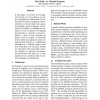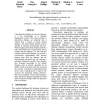COLING
2010
13 years 10 months ago
2010
In this paper, we present an investigation into the use of cue phrases as a basis for dialogue act classification. We define what we mean by cue phrases, and describe how we extra...
SIGDIAL
2010
14 years 1 months ago
2010
Classifying the dialogue act of a user utterance is a key functionality of a dialogue management system. This paper presents a data-driven dialogue act classifier that is learned ...
COLING
2002
14 years 2 months ago
2002
In this paper, we describe a first prototype of a pattern-based analyzer developed in the context of a speech-to-speech translation project using a pivot-based approach (the pivot...
ACL
1998
14 years 4 months ago
1998
For the task of recognizing dialogue acts, we are applying the Transformation-Based Learning (TBL) machine learning algorithm. To circumvent a sparse data problem, we extract valu...
ACL
2003
14 years 4 months ago
2003
Discourse chunking is a simple way to segment dialogues according to how dialogue participants raise topics and negotiate them. This paper explains a method for arranging dialogue...
LREC
2008
14 years 4 months ago
2008
We present recent work in the area of Cross-Domain Dialogue Act (DA) tagging. We have previously reported on the use of a simple dialogue act classifier based on purely intra-utte...
LREC
2008
14 years 4 months ago
2008
In this paper the dialogue act annotation of naive and expert annotators, both annotating the same data, are compared in order to characterise the insights annotations made by dif...
COLING
2008
14 years 4 months ago
2008
We present recent work in the area of Cross-Domain Dialogue Act tagging. Our experiments investigate the use of a simple dialogue act classifier based on purely intra-utterance fe...
CICLING
2006
Springer
14 years 6 months ago
2006
Springer
In this paper, the influence of intonation to recognize dialogue acts from speech is assessed. Assessment is based on an empirical approach: manually tagged data from a spoken-dial...
CICLING
2006
Springer
14 years 6 months ago
2006
Springer
In this paper a theory of dialogue acts analysis in problem-solving tasks-oriented conversations is presented. The theory postulates that in practical dialogues every transaction h...






